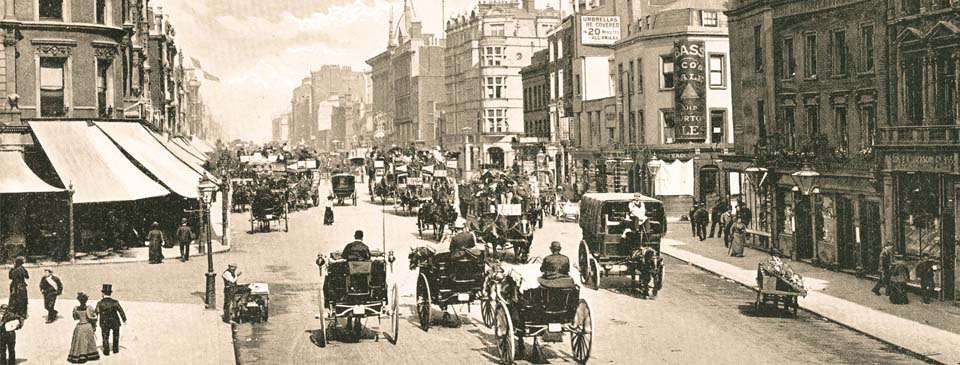Horses and carriages in the Victorian era

A typical working day in Oxford Street at the end of the 19th century, looking east, with New Bond Street off to the right. We can see omnibuses, hansom cabs, and delivery carts.
The main form of transport in London and elsewhere until the early part of the 20th century was by horse, or was horse-drawn. Individuals owned horses; more affluent house-holds owned or hired carriages; and goods were delivered by wagon and cart. Hackney carriages were superseded by the faster hansom cabs in the mid-century. From the 1830s horse-drawn omnibuses, and later trams, were able to speedily transport huge numbers of people.
During the Victorian era, many of London’s streets were filled with all manner of horse-drawn wagons and carts, delivering every type of merchandise. Goods arrived from around the country at London’s many rail termini, or at London’s extensive dock system from further afield, and all had to be transported by cart to their final destination. London was then a manufacturing centre, with the need for finished or part-finished products to be moved around. In residential districts milk, bread, and other foodstuffs were delivered to the door. Pet food could be purchased from cat’s-meat men and women, who pushed their barrows around the streets filled with horse remains from the knackers’ yards, crying “meat, meat”.
There were around 120,000 haulage workers in London and Middlesex at the end of the 19th century, including those working on omnibuses. About 68,000 of them were carmen and carters. Some worked for large businesses such as Pickfords (who owned over four thousand horses at the end of the century), or Carter Paterson’s, or for railway companies. Others were individuals with one or more vans. The hours were long and pay was low.
Before the development of the rail network, some of London’s food produce arrived each day at Covent Garden market from the surrounding countryside on horse-drawn wagons. Until the Victorian era, fish was landed at Billingsgate market by boat. Later, trains allowed it to speedily arrive in London from as far as Hull, Grimsby, Fleetwood, and eventually Penzance and Scotland. Yet, even after the development of the railways, produce still had to be conveyed from London’s rail termini to the wholesale markets by horse-drawn cart.
Meat had for centuries arrived in London from farms on the hoof. In the mid-century around 35,000 animals were herded through London’s streets on each of two days per week and, as London’s population grew, the number of animals slaughtered each year increased. To prevent this herding into town with its noise and mess, the City of London Corporation acquired the large open site of Caledonian Fields in Islington and there created a meat market with abattoirs. In 1862 they opened an enlarged Smithfield Meat Market on the site of the former livestsock market. The meat needed to be transported between the Caledonian Market and Smithfield, and from there to individual butchers, however, which was undertaken on horse-drawn carts. Railway companies also developed special express trains to bring meat from afar to special depots in London, such as Nine Elms, and from there by cart to Smithfield.
In the first half of the century there were various fairs and markets in and around London at which horses were bought and sold, such as at Greenwich, Catford, Camberwell, Ealing and Croydon. Fridays were given over to the sale of horses at the Smithfield livestock market, which was notorious for attracting thieves. Few horse markets lasted beyond the mid-century, although the horse fair at Barnet, where gypsies gathered, lasted into the 20th century. Many visitors to these markets took pleasure in the cruelty that was inflicted there on the animals and that was perhaps a reason for their gradual suppression.
Wagonettes, usually drawn by two or three horses, took Londoners on trips out to the countryside. Ten or more people could sit on either side. Sunday school children from poorer districts were taken for their annual treat to Epping Forest and elsewhere. Similarly, workers enjoyed their works’ outings. Pleasure vans, similar to delivery carts but with seats, could carry large numbers of children.
Grey horses were preferred for wedding carriages. Funeral cortège carriages, pulled by Flemish black horses, could be quite ostentatious. The carriages varied according to the budget available but many working people paid weekly into an insurance fund or burial club, allowing for a relatively expensive carriage. Some of the largest funerals were for a publican or his wife.
In the early part of the 19th century many of the middle classes owned a horse to make private or business journeys. Wealthier homes or professional people kept a horse and carriage. It was estimated that in the mid-century there were about 25,000 individual horses being ridden in London on most days, and probably more in earlier decades. The situation gradually changed during the century as various forms of public transport – omnibuses, trams and trains – became widespread. By the latter part of the 19th century there were few individual horse-riders on London’s streets except for the police and army but many types of horse-drawn vehicles proliferated.
In the suburbs many detached or semi-detached houses had a stable. Where that was not the case a stable could be rented from a neighbour, and perhaps a coach-house if required. ‘Livery & Bait’ stables were common, where an owner could pay to have their horse stabled and fed, or horses could be hired. Many inns, particularly coaching inns and those associated with hunting, kept stables at the rear of the premises. Some stables were less scrupulous, however, and owners had to be careful that their animals were receiving all the food for which they had paid. Many of the horses pulling commercial wagons and vans on London’s streets were hired from stables rather than owned by the operator.


